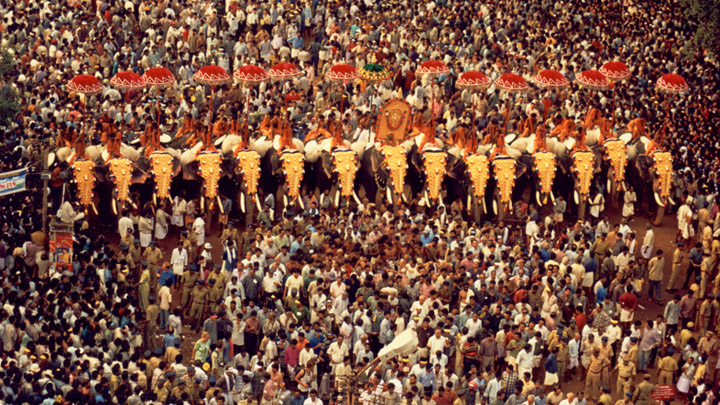Thrissur Pooram (Malayalam: തൃശ്ശൂര് പൂരം) is one of the most popular temple festivals of the South Indian state Kerala. It is held at the Vadakkunnathan Temple in Thrissur town every year on the 'Pooram' (Malayalam: പൂരം, pronounced [puːɾam]) day of the Malayalam Calendar month of 'Medam'. 'Pooram' day is the day when the moon rises with the Pooram star. People from all over the world would reach thrissur to celebrate pooram. Thrissur pooram is famous all over the world. People celebrate pooram without any religious difference

History
Thrissur Pooram was the brain child of Raja Rama Varma or famously known as Sakthan Thampuran, the Maharaja of Cochin (1790–1805). Before the start of Thrissur Pooram, the largest temple festival in Kerala was the one-day festival held at Aarattupuzha knows asArattupuzha Pooram. Temples in and around City of Thrissur were regular participants. One day because of incessant rains they were late for the Arattupuzha Pooram and were denied access to the Pooram procession. Felt embarrassed by the denial, the temples went to theSakthan Thampuran and told their story.
So in 1798, he unified the 10 temples situated around Vadakkunnathan Temple and organised the celebration of Thrissur Pooram as a mass festival. He invited temples with their deities to City of Thrissur to pay obeisance to Lord Vadakkunnathan, the presiding deity of theVadakkunnathan Temple. Sakthan Thampuran ordained these temples into two groups, Western group and Eastern group. The Western group as Thiruvambadi Sri Krishna Temple consisting of Kanimangalam, Laloor, Ayyanthole and Nethilakkavu as the main one.
The Eastern group called as Paramekkavu Bagavathi Temple, consisting in addition to Paramekkavu temple, Karamukku, Chembukavu, Choorakottukavu and Panamukkamppilly. The Pooram was to be centered around the Vadakkunnathan Temple, with all these temples sending their Poorams (the whole procession), to pay obeisance to the Shiva, the presiding deity. The Thampuran is believed to have chalked out the program and the main events of the Thrissur Pooram festival
Participants
Principle participants are Paramekkavu Bagavathi Temple and Thiruvambadi Sri Krishna Temple.
Western Group
- Thiruvambadi Sri Krishna Temple
- Kanimangalam Sastha Temple
- Laloor Bhagavathy Temple
- Sree Karthyayani Temple at Ayyanthole
- Neithilakkavu Bhagavathy Temple
Eastern Group
- Paramekkavu Bagavathi Temple
- Chembukkavu Bhagavathy Temple
- Panamukkumpally Sastha Temple
- Choorakkottukavu Bhagavathy Temple
- Pookkattikkara - Karamukku Baghavathy Temple
Flag Hoisting (Kodiyettam)
The Pooram celebrations begins seven days before the main Pooram. It starts with the ceremonial flag hoisting (Kodiyettam) by various participating temples. There will be a ceremonial flag hoisting at Naduvilal and Naikkanal in Thrissur City also.
Display of fireworks (First Round)
The first round of pyrotechnics, know as Sample Vedikettu, happens on the fourth day after the flag hoisting of the Pooram. It is a one hour show by presented by Thiruvambady and Paramekkavu Devawsoms. Swaraj Round is venue for this fireworks and starts at 7:15 PM in the evening. The display usually have innovative patterns and varieties of fireworks display.
Display of Caparisons
The golden elephant caparison (Nettipattam), elephant accoutrements (Chamayam), ornamental fan made of peacock feathers (Aalavattom), royal fan (Venchamarom), sacred bells and decorative umbrellas are prepared new by Thiruvambady and Paramekkavu Devawsoms separately. Paramekkavu Devaswom exhibits this at the Agrasala in ThrissurCity and the Thiruvambady Devaswom will display the caparisons at the Church Mission Society High School in Thrissur City on fourth and fifth day before the Pooram.
Main Pooram
The main Pooram starts on the sixth day after the flag hoisting. The first to enter the Vadakkunnathan Temple on Pooram day is Kanimangalam Sastha Temple through southern gopuram and exits through western goupuram. The next to follow is Chembukkavu Bhagavathy Temple, Panamukkumpally Sastha Temple and Paramekkavu Bagavathi Templewho enters through eastern goupuram and leaves through southern goupuram. The other Poorams of Laloor Bhagavathy Temple, Neithilakkavu Bhagavathy Temple, Choorakkottukavu Bagavathy Temple enter Vadakkunnathan Temple through western goupuram leaves through southern goupuram. The Pookkattikkara - Karamukku Baghavathy Temple enters through western goupuram and leaves through southern goupuram. The Thiruvambadi Sri Krishna Temple enters Vadakkunnathan Temple through western gopuram and leaves through southern gopuram. Later all Poorams conclude at Nilapaduthara near western goupuram of Vadakkunnathan Temple.
Display of fireworks (Main Round)
The main fire works happens on the seventh day after the flag hoisting. It takes place at 3 AM in the morning at Swaraj Round in Thrissur City ending at 6
Farewell Ceremony
The seventh day of Pooram is the last day of Pooram. Upacharam Cholli Piriyal (Farewell Ceremony) is last event held at Swaraj Round. Thiruvambadi Sri Krishna Temple andParamekkavu Bagavathi Temple idols were taken from the Swaraj Round to their respective temples mark the end of the Pooram celebrations. The festival will end with display of fireworks know as Pakal Vedikkettu.
Cultural Influences
Despite being a Hindu festival, the Thrissur pooram is attended by different sections of the Kerala society. Several replicas of the festival are held in places within Kerala as well as outside the state.

Controversies
For the fireworks ceremony, which is held as two parts - a sample one (called Sample Vedikkettu, held one day before the pooram) and the final one, chemicals are used extensively. This has caused several allegations against the organizers for violating the regulations regarding sound pollution. In the past, there were several accidents during the event as well during the manufacture of fireworks chemicals, which has caused in the deaths of several people.
Another topic of concern is the use of elephants. Due to the competitive nature of the festival between Paramekkavu and Thiruvambadi temples, as well as the presence of cheru poorams elephants are used continuously as well as in large numbers. This has caused elephants to collapse [as well as to run amok. This has caused concern among the animal activists as well as the common people. Though the government has issued several guidelines regarding the parading of elephants in the festivals, there are several allegations of them being not observed strictly.

No comments:
Post a Comment